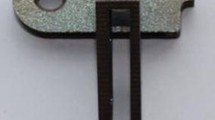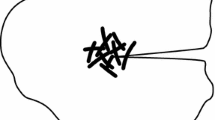Abstract
Three different woods (lignum vitae; black fiber palm; spruce) were investigated regarding their friction and wear properties under abrasion and sliding. For the abrasive wear against silicon carbide paper, the palm wood gave the lowest removal of material, especially under an orientation of the black fibers normal to the contact region (on R–T-plane in R-direction). At the same time, this material had the highest anisotropy. Slightly less abrasion resistant was lignum vitae, whereas spruce was most easily abraded. This can be considered as an indication that spruce can easily be machined. Under sliding conditions against smooth steel, a similar tendency, but at much lower wear rates compared to abrasion, was found. The relatively high coefficient of friction under dry sliding allows the use of these woods as friction materials, for example in brakes. Additional lubrication of the two best woods, lignum vitae and black fiber palm, by soaked sunflower oil brought the coefficient of friction to a much lower level, so that the use of these woods as bearing materials in various applications is promising.
















Similar content being viewed by others
References
American Conifer Society (1983) https://en.wikipedia.org/wiki/Spruce. Accessed 16 Nov 2020
Atack D, Tabor D (1958) The friction of wood. Proc R Soc Lond A Math Phys Eng Sci R Soc 246(1247):539–555
Brookhaven National Laboratory (2009) https://phys.org/news/2009-04-gene-biofuel-production.html. Accessed 16 Nov 2020
Butterfield BG, Meylan BA (1980) Three-dimensional structure of wood: an ultrastructural approach. The structure of palm wood, Chapter 3. Springer, New York, pp 48–55 (ISBN: 978-94-011-8148-8)
Chand N, Fahim M (eds) (2008) Tribology of natural fiber polymer composites. Woodhead Publ, Cambridge
Earth ORG (2014) Trees of Europe. https://www.earthorganization.org/europe/. Accessed 13 Nov 2020
Fathi L (2014) Structural and mechanical properties of the wood from coconut palms, oil palms and date palms. Dissertation, University of Hamburg, Germany
Fathi L, Frühwald A (2014) The role of vascular bundles on the mechanical properties of coconut palm wood. Wood Mater Sci Eng 9(4):214–223
Fischer C, Rion J, de Rijk S (2017) A different approach to natural fiber composites. JEC Compos Mag 114:42–44
Forest Product Laboratory (1980) Structure of Wood, United States Department of Agriculture, Research Note FPL-04
Friedrich K, Akpan EI, Wetzel B (2017) Structure and mechanical / abrasive wear behavior of a purely natural composite: black-fiber palm wood. J Mater Sci 52(17):10217–10229
Friedrich K, Akpan EI, Wetzel B (2018) Sliding wear performance of dry and oil impregnated black-fiber palm wood. J Tribol 16:51–70
GfT (2014) Gesellschaft für Tribologie eV, Arbeitsblatt 7: Verschleiß, Reibung: Definitionen, Begriffe, Prüfung. (Society for Tribology, Working Instruction 7: Wear, Friction: Definitions, Terms, Testing). gftev.de/wpcontent/uploads/2014/07/2002
Gibson LJ (2012) The hierarchical structure and mechanics of plant materials. J R Soc Interface 9:2746–2766
Guan N, Thunell B, Lyth K (1983) On the friction between steel and some common Swedish wood species. Holz Roh- Werkst 41(2):55–60
Iida R, Ohtani T, Nakai T, Adachi K (2014) Changes in wood temperature under high-speed friction. J Wood Sci 60(5):313–320
Lemoine TJ, Koch P (1974) Coefficient of friction of dry slash pine and southern oak on three tension-grip facings. Wood Sci 7(3):182–184
Lemoine TJ, McMillin CW, Manwiller FG (1970) Wood variables affecting the friction coefficient of spruce pine on steel. Wood Sci 2(3):144–148
Li L, Gong M, Li D (2013) Evaluation of the kinetic friction performance of modified wood decking products. Constr Build Mater 40:863–868
McKenzie WM, Karpovich H (1968) The frictional behaviour of wood. Wood Sci Technol 2(2):139–152. https://doi.org/10.1007/BF00394962
McLaren KG, Tabor D (1961) The frictional properties of lignum vitae. Br J Appl Phys 12(3):118–120
McMillin CW, Lemoine TJ, Manwiller FG (1970) Friction coefficient of oven-dry spruce pine on steel, as related to temperature and wood properties. Wood Fiber Sci 197(1):6–11
Meier E (2008a) Wood. https://www.wood-database.com/lignum-vitae/. Accessed 16 Nov 2020
Meier E (2008b) Wood. http://www.wood-database.com/blackpalm/. Accessed 16 Nov 2020
N.N. (2012) Wooden brake shoes in Montreal Metro. https://www.youtube.com/watch?v=MdvQLYC5hGc. Accessed 16 Nov 2020
Niemz P, Sonderegger W (2017) Holzphysik- Physik des Holzes und der Holzwerkstoffe. (Wood physics—physics of wood and wood-based products) (In German), 580 S. Fachbuchverlag Leipzig im Carl Hanser Verlag, München
Ohtani T (2008) The effects of mechanical parameters of the stress–strain diagram on wood abrasion. Wear 265(11–12):1557–1564
Ohtani T, Yakua T, Kitayama S (2001) Two body and three body abrasive wear properties of katsura wood. J Wood Sci 47:87–93
Ohtani T, Inoue A, Tanaka C (2002) Abrasive wear properties of compressed sugi wood. J Wood Sci 48:473–478
Park C-Y, Kim C-K, Kim H-K, Lee J-J (2011) Evaluation of friction properties according to normal force and direction of wood grain in real contact area. J Korean Wood Sci Technol 39(5):437–443
Pobko Inc (2008) http://news.thomasnet.com/fullstory/hardwood-bearings-resist-corrosion-and-abrasion-542884. Accessed 16 Nov 2020
Poletto M, Zattera AJ, Forte MMC, Santana RMC (2012) Thermal decomposition of wood: Influence of wood components and cellulose crystallite size. Bioresour Technol 109:148–153
Ramakrishnan K (2015) Autonomous GPS brakes. 3rd year mechanical engineering | Georgia Institute of Technology, Atlanta. http://www.dbrake.com/braking-history.php
Sahari J, Sapuan SM, Ismarrubie ZN, Rahman MZA (2012a) Physical and chemical properties of different morphological parts of sugar palm fibers. Fibres Textiles East Europe 20(2):21–24
Sahari J, Sapuan SM, Zainudin ES, Maleque MA (2012b) Sugar palm tree: a versatile plant and novel source for biofibres, biomatrices, and biocomposites. Polym Renew Resour 3(2):61–77
Sathre R, Gorman TM (2005) Improving the performance of wooden journal bearings. For Prod J 55(11):41–47
Seki M, Sugimoto H, Miki T, Kanayama K, Furuta Y (2013) Wood friction characteristics during exposure to high pressure: influence of wood/metal tool surface finishing conditions. J Wood Sci 59(1):10–16
Steurnagle JR (2005) Wood bearings in the new millennium. Woodex Bearing Co., Plant Services No. 469
Svensson BA, Nyström S, Gradin PA, Höglund H (2009) Frictional testing of wood: Initial studies with a new device. Tribol Int 42(1):190–196
Wikipedia (2020) Lignum vitae. https://en.wikipedia.org/wiki/Lignum_vitae. Accessed 16 Nov 2020
Wright Brothers. Org. (2015) https://en.wikipedia.org/wiki/Wright_Flyer. Accessed 16 Nov 2020
Yin W, Liu Z, Tian P, Tao D, Meng Y, Han Z, Tian Y (2016a) Tribological properties of wood as a cellular fiber-reinforced composite. Biotribology 5:67–73. https://doi.org/10.1016/j.biotri.2015.09.005
Yin W, Lu H, Zheng Y, Liu Z, Han Z, Tian Y (2016b) Influence of water and oil immersion on the tribological properties of Excentrodendron hsienmu. Sci China Technol Sci 59(11):1673–1679. https://doi.org/10.1007/s11431-016-0223-7
Acknowledgements
The authors are grateful to various colleagues in IVW GmbH who carried out some of the tribological tests and structural analyses. One of us, Dr. E. I. Akpan expresses his thanks to the Alexander von Humboldt Foundation for his Georg Forster research fellowship. Besides, the support of the German Academic Exchange Organization (DAAD Project Number 1700100000) and the Thailand Research Fund for a common wood research project is highly esteemed.
Author information
Authors and Affiliations
Corresponding author
Additional information
Publisher's Note
Springer Nature remains neutral with regard to jurisdictional claims in published maps and institutional affiliations.
Rights and permissions
About this article
Cite this article
Friedrich, K., Akpan, E.I. & Wetzel, B. On the tribological properties of extremely different wood materials. Eur. J. Wood Prod. 79, 977–988 (2021). https://doi.org/10.1007/s00107-020-01654-2
Received:
Accepted:
Published:
Issue Date:
DOI: https://doi.org/10.1007/s00107-020-01654-2




